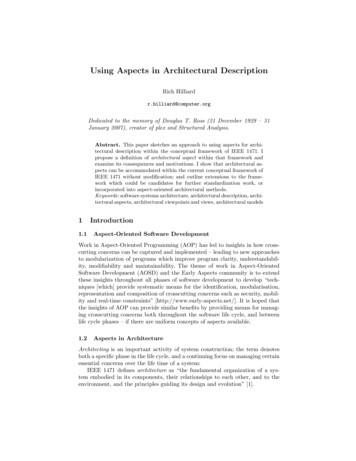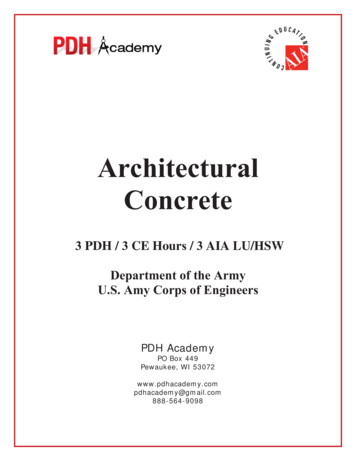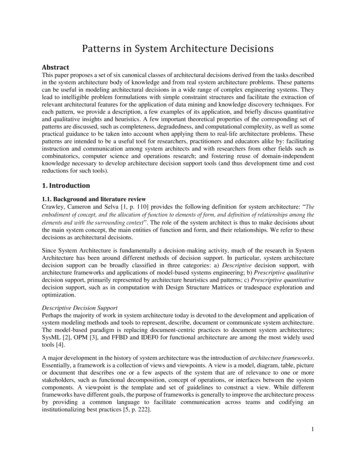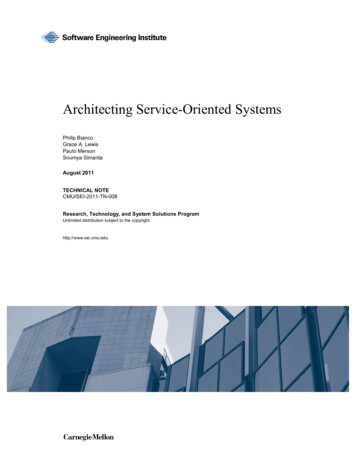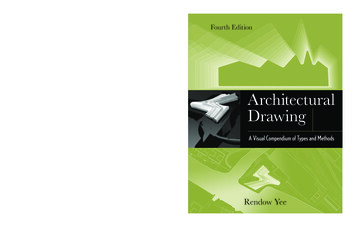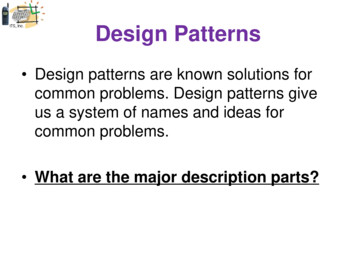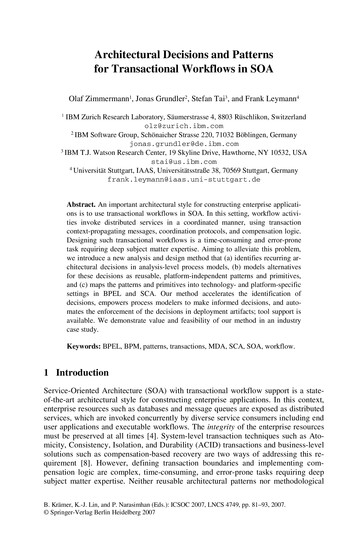
Transcription
Architectural Decisions and Patternsfor Transactional Workflows in SOAOlaf Zimmermann1, Jonas Grundler2, Stefan Tai3, and Frank Leymann41IBM Zurich Research Laboratory, Säumerstrasse 4, 8803 Rüschlikon, Switzerlandolz@zurich.ibm.com2 IBM Software Group, Schönaicher Strasse 220, 71032 Böblingen, Germanyjonas.grundler@de.ibm.com3 IBM T.J. Watson Research Center, 19 Skyline Drive, Hawthorne, NY 10532, USAstai@us.ibm.com4 Universität Stuttgart, IAAS, Universitätsstraße 38, 70569 Stuttgart, . An important architectural style for constructing enterprise applications is to use transactional workflows in SOA. In this setting, workflow activities invoke distributed services in a coordinated manner, using transactioncontext-propagating messages, coordination protocols, and compensation logic.Designing such transactional workflows is a time-consuming and error-pronetask requiring deep subject matter expertise. Aiming to alleviate this problem,we introduce a new analysis and design method that (a) identifies recurring architectural decisions in analysis-level process models, (b) models alternativesfor these decisions as reusable, platform-independent patterns and primitives,and (c) maps the patterns and primitives into technology- and platform-specificsettings in BPEL and SCA. Our method accelerates the identification ofdecisions, empowers process modelers to make informed decisions, and automates the enforcement of the decisions in deployment artifacts; tool support isavailable. We demonstrate value and feasibility of our method in an industrycase study.Keywords: BPEL, BPM, patterns, transactions, MDA, SCA, SOA, workflow.1 IntroductionService-Oriented Architecture (SOA) with transactional workflow support is a stateof-the-art architectural style for constructing enterprise applications. In this context,enterprise resources such as databases and message queues are exposed as distributedservices, which are invoked concurrently by diverse service consumers including enduser applications and executable workflows. The integrity of the enterprise resourcesmust be preserved at all times [4]. System-level transaction techniques such as Atomicity, Consistency, Isolation, and Durability (ACID) transactions and business-levelsolutions such as compensation-based recovery are two ways of addressing this requirement [8]. However, defining transaction boundaries and implementing compensation logic are complex, time-consuming, and error-prone tasks requiring deepsubject matter expertise. Neither reusable architectural patterns nor methodologicalB. Krämer, K.-J. Lin, and P. Narasimhan (Eds.): ICSOC 2007, LNCS 4749, pp. 81–93, 2007. Springer-Verlag Berlin Heidelberg 2007
82O. Zimmermann et al.support exist today; development tools do not guide process modelers sufficiently.This lack of support is diametrically opposed to SOA design goals such as increasedagility, flexibility, and reusability – in our opinion, a key inhibitor for real-worldadoption of transactional workflows in SOA.In this paper, we introduce a new analysis and design method that aims to eliminatethis inhibitor by combining architectural decision modeling techniques, reusable patterns composed of primitives, and mappings of the primitives to concrete technologiessuch as the Business Process Execution Language (BPEL) and the Service ComponentArchitecture (SCA). Our method covers the entire lifecycle from analysis to conceptualdesign to technology selection and runtime engine configuration. This end-to-endcoverage speeds up the identification of design alternatives for transactional workflowsin SOA and helps to make the decision making process repeatable; architectural knowledge can be shared across project and technology boundaries. Pattern-aware designtools can map the primitives to platform-specific technology specifications anddeployment artifacts, e.g., in BPEL/SCA engines and other middleware.The remainder of this paper is organized in the following way. Section 2 definesthe context for our work. Section 3 scopes the problem to be solved by identifyingrecurring architectural decisions in a real-world case study. Section 4 defines threeconceptual transaction management patterns and three underlying primitives, alongwith an exemplary technology- and asset-level transformation. Section 5 discussesrelated work, and Section 6 concludes with a summary and an outlook to future work.2 BackgroundThe objective of our work is to support the design and development of enterpriseapplications that require transactional semantics. An example is a Customer Relationship Management (CRM) system that serves many concurrent users via multipleaccess channels and processes, including an Internet self-service and a call center. Inthis CRM, business-relevant customer profile information is persisted in databasesand accessed via Web-accessible services; external systems also have to be integrated.SOA and Web services. SOA reinforces general software architecture principlessuch as separation of concerns and logical layering. A defining element of SOA as anarchitectural style is the possibility to introduce a Service Composition Layer (SCL)[18], which promises to increase flexibility and agility and to provide better responsiveness to constantly changing business environments. (Re-)assembling workflows inthe SCL does not cause changes on the underlying service and resource layers; computational logic and enterprise resource management are separated from the servicecomposition. We refer to a SOA with such a SCL as a process-enabled SOA.XML-based Web services are a state-of-the-art implementation option for processenabled SOAs [19]. The Web Services Description Language (WSDL) [15] describesservice interfaces, SOAP [12] service invocation messages. BPEL [14] is a workflowlanguage with operational semantics that can be used to realize the SCL. Componentmodels for the implementation of services are emerging; SCA is such a model [9].Service components in SCA are defined from several perspectives: an interfacedescribing the input and output parameters of the operations of a component,references to other components, and component implementations. Via imports, acomponent implementation can reference external services.
Architectural Decisions and Patterns for Transactional Workflows in SOA83In the CRM example, let us assume that process-enabled SOA has been chosen asthe architectural style. The business processes to be implemented are modeled explicitly during requirements analysis; their execution as SCL workflows is later automated using a BPEL engine. The tasks in the processes are realized as atomic andcomposed Web services, which have a WSDL interface and can be invoked at runtime through transport protocol bindings, e.g., SOAP/HTTP. We further assume thatthese services are implemented as SCA components or integrated via SCA imports.Transactional workflows. In the CRM system, relational database tables and message queues provided by integration middleware [5] serve as enterprise resources persisting and exchanging customer profiles. Concurrent and distributed access totransactional enterprise resources can be coordinated by transaction managers, whichare in charge of ensuring the ACID properties; Relational Database ManagementSystems (RDBMS) and queue managers then take a local resource manager rolesubordinate to a transaction manager [8].The SCL in a process-enabled SOA can be seen as a workflow application. If aBPEL engine in the SCL serves as a transaction manager, its process flows becometransactional workflows [8]. Transactional workflows coordinate the outcome of thelocal and remote service invocations that access and manipulate the enterprise resources. Transactional workflows in process-enabled SOA are particularly challenging todesign due to the potentially long-lived nature of processes, the loose coupling andautonomy of services, the existence of non-transactional resources, and the diversityin coordination and communication protocols (synchronous and asynchronous message exchange patterns). Traditional system transactions alone are not directlyapplicable in a SOA setting; a more decentralized coordination model and application-level compensation strategies have to be added. To address these needs,WS-Coordination, WS-AtomicTransaction (WSAT), and WS-Business Activity Framework (WBAF) complement the Web services specifications introduced above [17].3 Recurring Architectural Decisions in Process-Enabled SOAToday’s SOA tools use default transaction management settings when translating analysis-level process models into BPEL workflows, Web services and SCA components[20]. Often, these settings are inappropriate and have to be changed during the laterdevelopment steps. This is error-prone, platform-specific work; software qualityissues arise and technical project risk increases. This problem can be overcome by:A method for the systematic design of transaction management settings in processenabled SOA, which (a) identifies the required architectural decisions in analysislevel process models, (b) captures proven design options as patterns which facilitatethe decision making, and (c) transforms the patterns to platform-specific settings.Sample process. Refining our CRM example, we now discuss the SOA enablementof an existing system of a telecommunication service provider that is organized intoseveral Lines of Business (LOB), including wireline and wireless telephony. Thebusiness event triggering the sample process is a customer requesting an upgradefrom prepaid to regular wireless service, e.g., by calling a call center agent.
84O. Zimmermann et al.Figure 1 outlines this key business process in the CRM system, Upgrade Customer:Fig. 1. Sample CRM process: analysis-level BPM including enterprise resourcesThe analysis-level Business Process Model (BPM) specifies that first the customerstatus has to be determined (Determine Wireless Customer Status), so that the customer profile, an enterprise resource spread over several repositories, can be retrieved(Retrieve Wireless Customer Profile). Next, a tentative Upgrade Wireless CustomerProfile task is executed; however, the status change can only be finalized if a subsequent Reconcile Profile Upgrade task completes successfully. This task sends approval request messages to the two CRM systems of the wireline LOB. If any of theseCRM systems declines the upgrade or does not respond within a working day, theupgrade process has failed, and the wireless customer profile must remain unchanged.Other business processes work with the customer profile while this process is running.An analysis-level BPM such as Figure 1 is typically created by a business domainexpert, not a software architect or workflow technology specialist. Such a BPM is notdirectly executable in a workflow engine; typically it does not cover design concernssuch as data flow, resource protection, and error handling sufficiently. In the CRMexample, the customer profiles are the enterprise resources to be protected withsystem and/or business transactions.1 Another transactional enterprise resource mightbe the process instance state maintained by the engine; a BPEL engine in transactionmanager role may have to roll back process parts when handling errors, even if1Not all resources have to be protected by transactions, e.g. immutable resources meet theACID characteristics trivially. On the other hand, not all resources worth protecting canactually be protected by transaction managers, e.g., due to legacy system constraints.
Architectural Decisions and Patterns for Transactional Workflows in SOA85activities that do not participate in the same transaction (the one in which the BPELprocess runs) have been committed on the system level already.Recurring architectural decisions. It is technically feasible to transform the analysis-level BPM from Figure 1 into a design-level process model, e.g., via basicBPEL/SCA export utilities provided by commercial SOA tools [7]. However, suchpredefined transformations do not obey any architectural decisions that are made inresponse to project-specific requirements [20]. Many of these architectural decisionsmust be made for any process-enabled SOA, not just our CRM example: Which composition paradigm and resource protection approach should be selected? Who coordinates the transactions? Which invocation protocols are best suited to invoke servicesfrom the process activities in the SCL? Should the process activities and the serviceinvocations run in separate transaction islands or form a transaction bridge? Whichcompensation technology should be used, and where should it be placed?As step (a) of our method, Figure 2 organizes these recurring decisions by their abstraction level and scope. The abstraction level refines from conceptual issues such asselection of a composition paradigm (here: workflow) to technology and asset selection (here: BPEL language and BPEL engine). The scope of a decision assigns it to design model elements; in the CRM example, the activity transactionality has to bedecided for Reconcile Profile Upgrade and the other four tasks shown in Figure 1.Conceptual LevelProject Scope (e.g., CRM)Process Scope (Upgrade Customer)Q – Question (Architectural Decision)O – Option (Architecture stomCodeQRMI – Remote Message InvocationIIOP – Internet Inter-ORB ProtocolJMS – Java Messaging ServiceMOM – Message-Oriented MiddlewareJ2EE – Java 2 Enterprise tivity/Operation Scope (5 Tasks in BPM)OSystem Transactions(Global Transaction)OCompensation (Business Transaction)OProcess Engine inSCLOExternal Coordinator(Third Party)OWorkflowLanguageOQBPELNoneTechnology BPEL handler(and/or WBAF)OEngine-specificcompensationOCustom codeOQCompensationPlacementTransactionalityService LactivityOTransaction Islands(Section 4.1)OTransaction Bridge(Section 4.1)OStratified Stilts(Section 4.1)OSOAP/HTTPOSOAP/HTTP withWS-AT enabledORMI/IIOPOJMS, other MOMQEJB TransactionAttributeORelatedworkOSCAQSCA ReferenceQualifierO(Section4.2)QSCA InterfaceQualifierO(Section4.2)OJ2EEQSCA ImportQualifierO(Section4.2)QSCA Implementation QualifierO(Section4.2)Asset LevelWPS – WebSphere Process ServerQBPEL EngineSelectionOOIBM WPS(Section 4.2)OtherQTransactional ActivityBehavior in WPSO(Section 4.2)Fig. 2. Architectural decisions and alternatives for transactional workflows in SOA4 Architectural Patterns as Decision AlternativesAs step (b) of our method, we now introduce three conceptual patterns as solutionoptions (architecture alternatives) for the activity transactionality decision from
86O. Zimmermann et al.Figure 2. These conceptual patterns comprise of platform-independent primitives thatwe map to BPEL and SCA technology and engine deployment artifacts in step (c).The primitives are designed in such a way that other mappings can also be provided.4.1 Conceptual Patterns and PrimitivesThe tasks from Figure 1 require different transactional treatment: Determine WirelessCustomer Status does not change any enterprise resource; transactional execution isnot required. The retrieval should execute as fast as possible. Upgrade WirelessCustomer Profile updates wireless customer profiles; the service operation is colocated with that realizing the Retrieve Wireless Customer Profile task. Changes mustbe executed with all-or-nothing semantics. The CRM systems contacted in ReconcileProfile Upgrade offer messaging interfaces and may take days to respond. Still, all-ornothing semantics is required; if any of the reconciliation request messages returns anerror or times out, the updates to the wireless customer profile made by UpgradeWireless Customer Profile must be undone.TRANSACTION ISLANDS, TRANSACTION BRIDGE, and STRATIFIED STILTS are threepatterns commonly used to address resource protection requirements such as those inthe CRM. In theory, more design options exist; however, faithful to establishedpattern capturing principles, we only present patterns observed and proven in practice.Figure 3 illustrates the patterns on an abstract level; a more detailed pattern description follows later. The SCL is represented by the white boxes. It implements thetasks in the analysis-level BPM as process activities that are part of executableworkflows; two invoke activities I1 and I2 enclose a third activity U, which forexample may be a BPEL assign activity or another utility. S1 and S2 represent serviceproviders exposing operations. Service operation invocations are displayed as dottedlines. A contiguous light grey area represents a single global transaction as defined in[8], which may be extended if it is not enclosed by a solid black line.(1) Processactivities in SCLI1UI2I1S2S1UI2I1S2S1UI2(2) Communications infrastructure(3) ServiceprovidersS1Pattern 1:TRANSACTION ISLANDSPattern 2:TRANSACTION BRIDGES2Pattern 3:STRATIFIED STILTSFig. 3. Transaction context sharing options between process activities and service operationsThese patterns comprise of three types of primitives that correspond to thearchitectural layers from Figure 3: (1) Process Activity Transactionality (PAT) primitives for the process activities in the SCL. (2) Communications Transactionality (CT)primitives modeling the capabilities of the communications infrastructure (invocation
Architectural Decisions and Patterns for Transactional Workflows in SOA87I1UI2(1) PAT – Process ActivitySSI(ST-N) NewI(ST-J) JoinI(CT-AS)Asynchronous StratifiedI2(CT-ST)Synchronous TransactionalU(CT-SNT)Synchronous Non-TransactionalI1Transaction(PAT-N) New(PAT-J) Joinprotocol, component technology). (3) Service provider Transactionality (ST) primitives stating the capability and willingness of service providers to join a transaction.These primitive types are conceptual, platform-independent abstractions ofconcepts for example found in today’s BPEL/SCA technology, and can be viewed asdesign time statements of architectural intent. Figure 4 illustrates the primitives:SSS(2) CT – Communication(3) ST – Service ProviderFig. 4. Conceptual primitives as pattern building blocks (notation same as in Figure 3)To elaborate upon the defining characteristics of the patterns and the primitives, wenow present them in a format commonly used in the design patterns literature.Intent. All patterns and primitives share the objectives motivated in Sections 2 and 3:To protect enterprise resources against integrity and correctness threats that mayoccur during concurrent process execution, e.g., when multiple processes and activities in the SCL invoke distributed services via a SOA communication infrastructure.Pattern 1. Decoupled TRANSACTION ISLANDS (PAT-J CT-SNT ST-N in Figure 3)Problem. How to isolate SCL process activities from service operation execution?Solution. Do not propagate the transaction context from the SCL to the service.Example. In the CRM case study, this pattern is applicable for Determine WirelessCustomer Status. This analysis-level task is realized as a process activity that invokesa read-only operation which in this example should execute non-transactionally.Forces and consequences. If a service operation fails, the process navigation in theSCL is not affected, and vice versa. If a service works with shared enterprise resources, its operations must be idempotent, as they may be executed more than oncedue to the transactional process navigation in the SCL. In many cases, the serviceprovider must offer compensation operations, and higher-level coordination of thecompensation activities is required (e.g., via business transactions; various modelshave been proposed). In practice, this pattern is often selected as a default choice.Pattern 2. Tightly coupled TRANSACTION BRIDGE (PAT-J CT-ST ST-J shown inFigure 3); MULTIPLE BRIDGES variant (PAT-N CT-ST ST-J).Problem. How to couple process activity execution in the SCL and service operationexecution from a system transaction management perspective?
88O. Zimmermann et al.Solution. Configure process activities, communications infrastructure, and serviceproviders in such a way that the SCL transaction context is propagated to the service.Example. In the CRM case study, this pattern addresses the all-or-nothing requirements stated for Retrieve/Upgrade Wireless Customer Profile (co-located services).Forces and consequences. Process activities and the service operations invoked bythem execute in the same transaction. As a result, several service operations can alsoparticipate in the same transaction. Therefore, a natural limit for their response timesexists (“tens of seconds to seconds at most” [8]). If a service-internal processing erroroccurs, previous transactional work, which can include process navigation in the SCLand the invocation of other services, has to be rolled back. This pattern meets resourceprotection needs well on the system level, but often is not applicable, e.g., whenprocesses and operations run for days or months. Hence, a common variation of thispattern is to split an SCL process up into several atomic spheres [8], creatingMULTIPLE BRIDGES for selected process activity/service operation pairs. Executingthe process activities in a small number of transactions (single TRANSACTION BRIDGE)reduces the computational overhead for process navigation; splitting the process upinto several atomic spheres (MULTIPLE BRIDGES) increases data currency.Pattern 3. Loosely coupled STRATIFIED STILTS (PAT-J CT-AS ST-J in Figure 3)Problem. How to realize asynchronous, queued transaction processing in SOA?Solution. Use message queuing as SOA communication infrastructure.Example. In the CRM case study, this pattern must be applied for Reconcile ProfileUpgrade, as the wireline CRM systems only provide messaging interfaces (e.g., JMS);additional compensation logic is required. In Figure 3, I1 and S1 use stratified transactions (as defined in [8]) during service invocation; on the contrary, service S2 readsthe request message and sends the response message within a single transaction.Forces and consequences. Services do not have to respond immediately; the deliveryof the messages is guaranteed by the communications infrastructure. If the executionof the service operation fails, the process may not get an immediate response; additional error handling is required, often involving compensation logic. This pattern oftenis the only choice in process-enabled SOA, e.g., when integrating legacy systems.PAT primitives. As Figure 4 shows, Process Activity Transactionality (PAT) definestwo primitives for the SCL, transaction context sharing or Join (J), and transactioncontext separation or New (N). If set to PAT-J, a process activity executes in the sametransaction context as the adjacent activities in the same process; it joins an existingcontext. As a consequence, the process activity’s work might be rolled back if anyother process activity or service operation that participates in the same transactionfails. With PAT-N, a process activity is executed in a new transaction context. BothPAT-J and PAT-N are valid choices in all three composite patterns; PAT-J is shownin Figure 3 and commonly used in practice. In TRANSACTION BRIDGE, PAT-N modelsthe MULTIPLE BRIDGES variant. Deciding for PAT-N is justified if two process activities should be independent from each other from a business requirement point ofview. Furthermore, some process models contain loops that are too complex to fit into
Architectural Decisions and Patterns for Transactional Workflows in SOA89a single, short-lived system transaction (e.g., due to retries, refinement/completioncycles, and service provider limitations).CT primitives. We model three Communication Transactionality (CT) primitives,Synchronous Non-Transactional (CT-SNT), Synchronous Transactional (CT-ST),and Asynchronous Stratified (CT-AS). CT-SNT is used in the TRANSACTION ISLANDSpattern. It represents a synchronous service invocation from the process activity without propagation of the transaction context. As a consequence, the activity waits untilthe call to the service returns. Once the service has been called, there is no possibilityto influence the work the service conducts. For example, the CT-SNT service invocation may cause the transaction to exceed the maximum duration configured in theSCL, which may result in a transaction timeout and a subsequent rollback. With CTSNT, undoing the work of the service can not be included in this rollback.CT-ST is required to build a TRANSACTION BRIDGE. It models a synchronous service invocation with transactional context propagation. As a consequence, the processactivity waits until the call to the service returns; a rollback may occur after theservice execution has completed (the service participates in the SCL coordination).CT-AS is part of the STRATIFIED STILTS pattern. It represents an asynchronousservice invocation without transaction context propagation. In CT-AS, long-runningservices can be invoked without loosing transactional behavior, as the processnavigation is part of a stratified transaction [8]. At least three transactions areinvolved in the invocation of a long-running service: the request message is sent in afirst transaction; in a second transaction, the message is received by the serviceprovider and the response message is sent; in a third transaction, the process activityreceives the response from the service. As shown in Figure 3, depending on theservice implementation, the second transaction (provider side) may be split up intotwo transactions: receive the message and commit, and later on, send the response in anew transaction. Such stratification details are described further in [8].ST primitives. Two choices and corresponding primitives exist for the ServiceProvider Transactionality (ST): join an incoming transaction (ST-J) or create a newone (ST-N). ST-J is used in TRANSACTION BRIDGE, ST-N in TRANSACTION ISLANDS.In ST-J, the service provider participates in the transaction of the caller (if a transaction exists). As a consequence, process activity execution in the SCL and the invokedservice operation influence each other, e.g., when causing a rollback. In ST-N, theservice provider does not participate in the incoming transaction. As a consequence, ifthe transaction in which the process activity runs is rolled back and the activity isretried later (e.g., due to process engine-specific error handling procedures), the service may operate on enterprise resources that have been modified in the meantime.4.2 Sample Mapping of Primitives to BPEL/SCA Technology and EngineAs step (c) of our method, we now map the three PAT, CT, and ST primitives toBPEL and SCA and other technology platforms. We expect that BPEL enginesprovide settings that allow configuring the transactional behavior at least for invokeactivities. Services are invoked via protocols such as SOAP/HTTP, IIOP and JMS,which differ in their support for transaction context propagation and (a)synchrony.The transactional behavior of SCA components is defined by SCA qualifiers.
90O. Zimmermann et al.Qualifiers specify the behavior desired from the point of view of the service consumer(SCA reference and SCA import) and the service provider (SCA interface, SCAimplementation).(1) The PAT primitive from Figure 4 does not have a direct BPEL realization; typically, BPEL engine vendors add proprietary support for it. Furthermore, additionalstandardization work is underway; for example, the BPEL for Java (BPEL4J) specification introduces ACID scopes [2]. The exact semantics are BPEL engine-specific.For example, during a rollback an engine may let the entire process fail, request resolution by a human operator, or retry one or more activities at a later point in time (potentially with a different transactional scope). While this is engine-specific behavioroutside of the scope of the BPEL specification, the process modeler must be aware ofit when selecting between PAT-J and PAT-N. (2) CT-SNT as a synchronousinvocation not propagating the transactional context maps to SOAP/HTTP or IIOP astransport protocol. CT-ST maps to SOAP/HTTP with WS-AtomicTransaction supportor to IIOP. CT-AS can be implemented with JMS; however, no standardized WSDLbindings exist at present. CT also determines the SCA qualifiers on reference, import,and interface level, e.g., SuspendTx and JoinTx. (3) ST can be mapped to the SCAqualifier Transaction on component implementation level.Table 1 maps the three conceptual patterns from Section 4.1 to CT and STprimitives and corresponding SCA qualifiers. At the time of writing, these qualifiersresided in a non-standard namespace [7], not yet in one of the emerging SCAstandards [9]. The full mapping reference can be provided.Table 1. Mapping of conceptual patterns to primitives and SCA LANDSTRANSACTIONBRIDGESTRATIFIEDSTILTSCTSCA reference(BPEL process as component invokingothers)CT-SNTCTSCA import(reference toexternal service)CT-SNTCTSCA interface (serviceprovidercomponent)CT-SNTSTSCA implementation(service providercomponent)ST-N (or ST-J)DeliverAsyncAt n/aSuspendTx trueJoinTx falseJoinTx falseTransaction local global anyCT-STCT-STCT-STST-JDeliverAsyncAt n/aSuspendTx falseJoinTx trueJoinTx trueTransaction globalCT-ASCT-ASCT-ASST-JDeliverAsyncAt commitSuspendTx falseJoinTx n/aJoinTx n/aTransaction globalMapping to IBM WebSphere Process Server (WPS). WPS [7] provides a BPELengine, which exposes processes and services as SCA components; in WPS, a BPELbased SCL connects to the underlying architectural layers via SCA. The SCA qualifiers from Table 1 govern the transactional context propagation and behavior.Furthermore, PAT translates into a proprietary invoke activity configuration attributecalled tran
A method for the systematic design of transaction management settings in process-enabled SOA, which (a) identifies the required architectural decisions in analysis-level process models, (b) captures proven design options as patterns which facilitate the decision making, and (c) transforms the pattern
